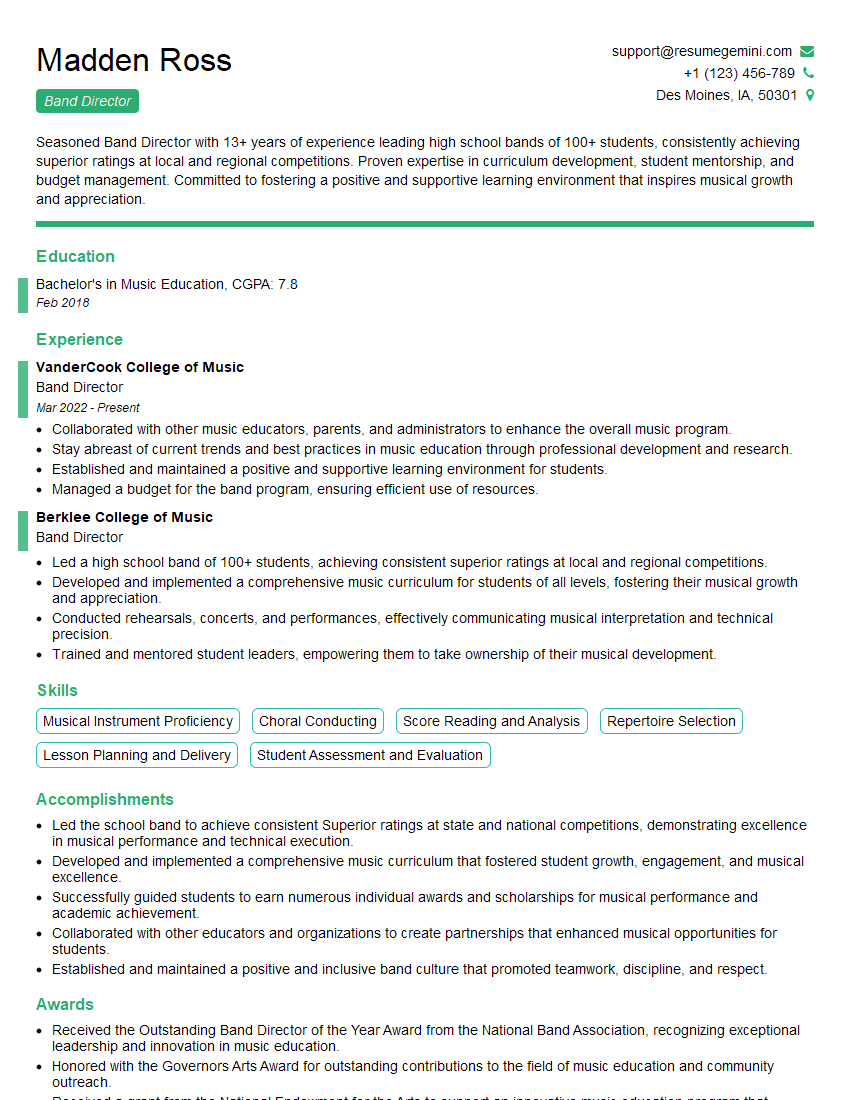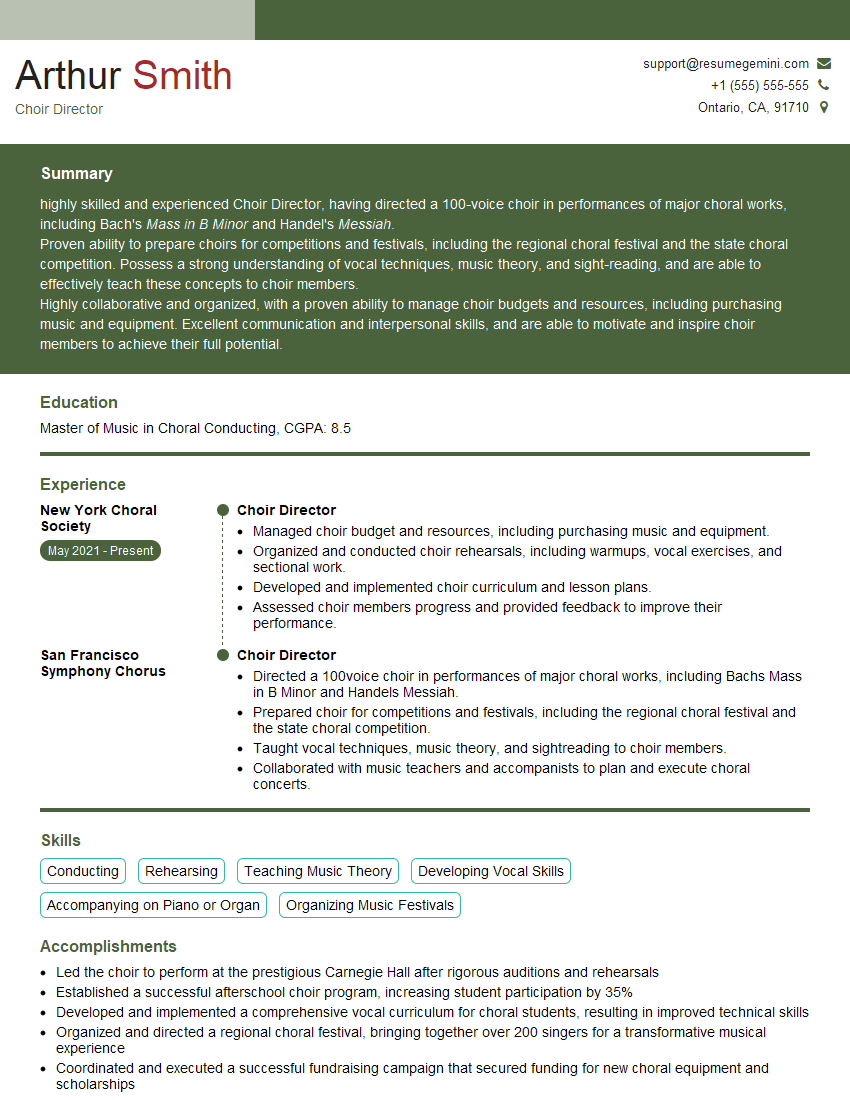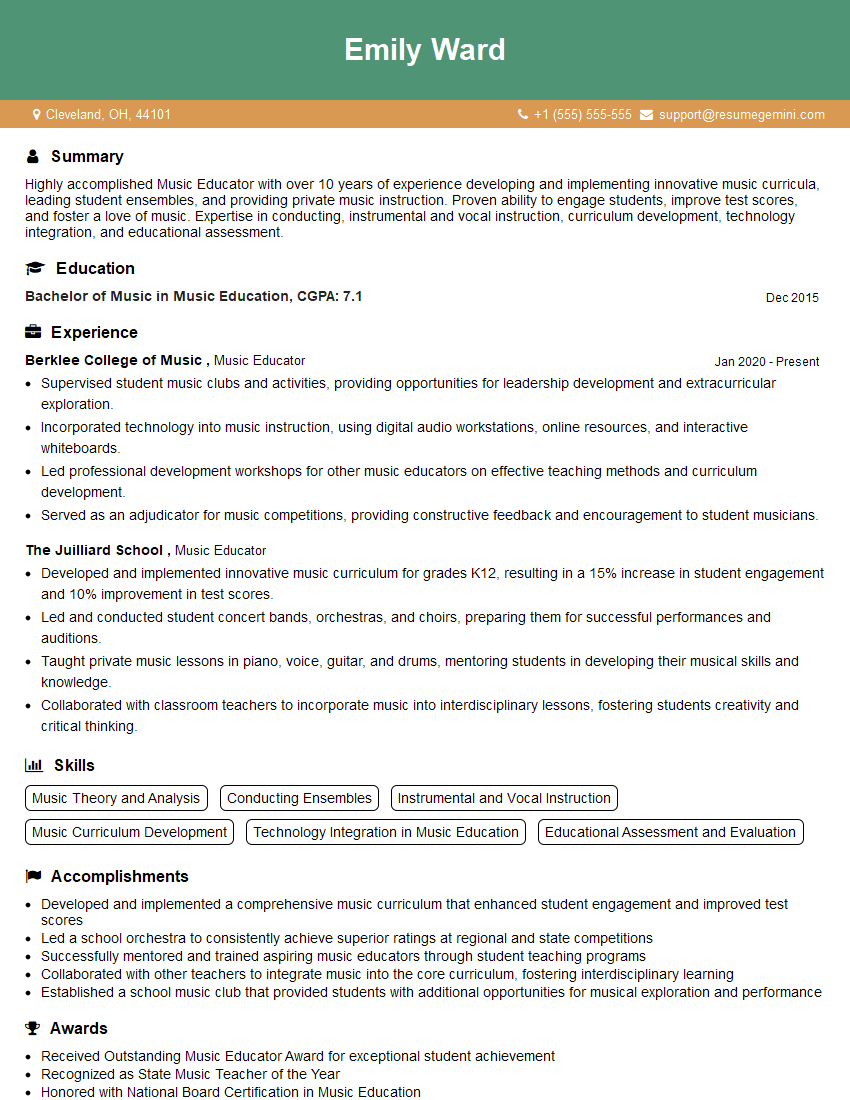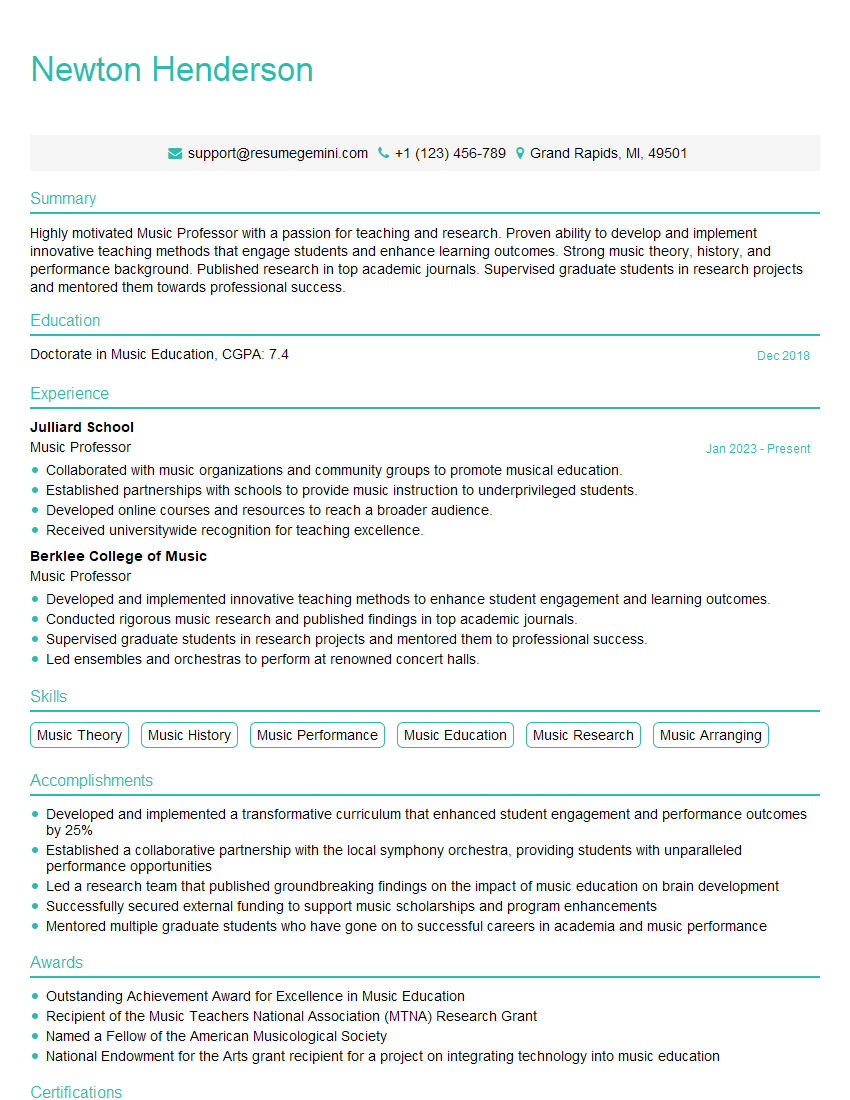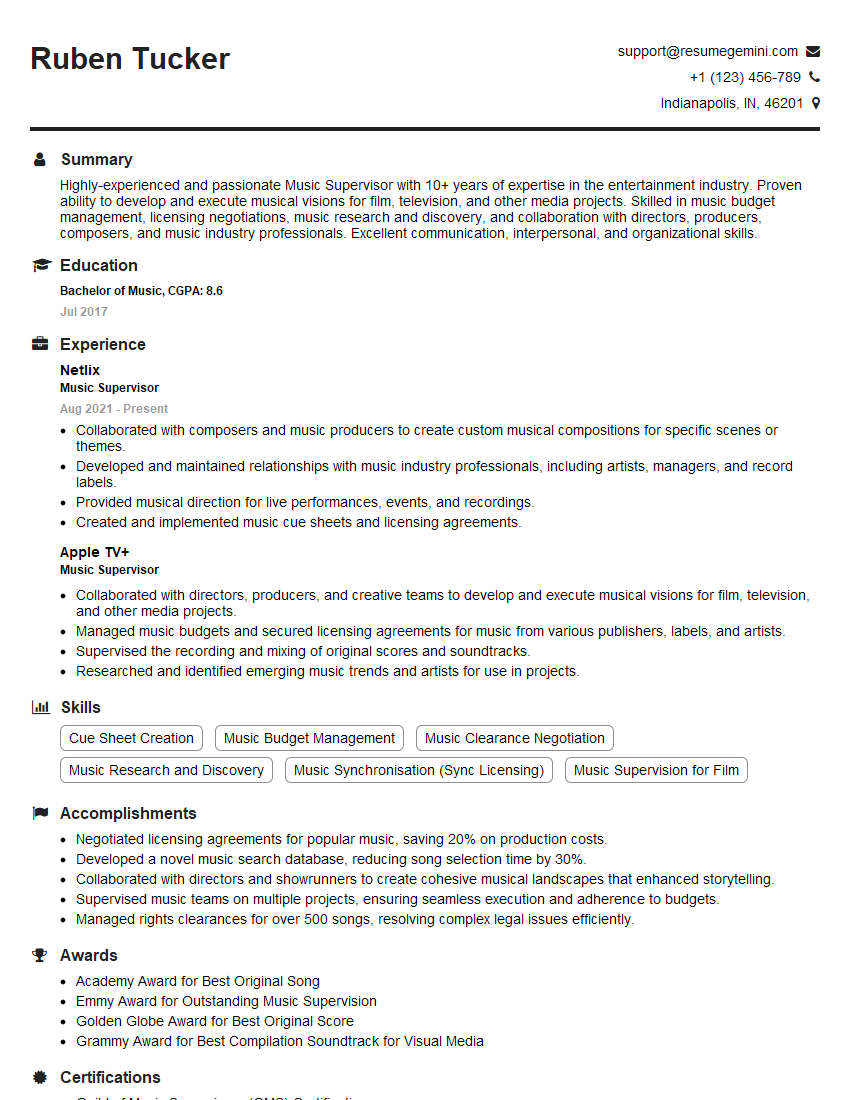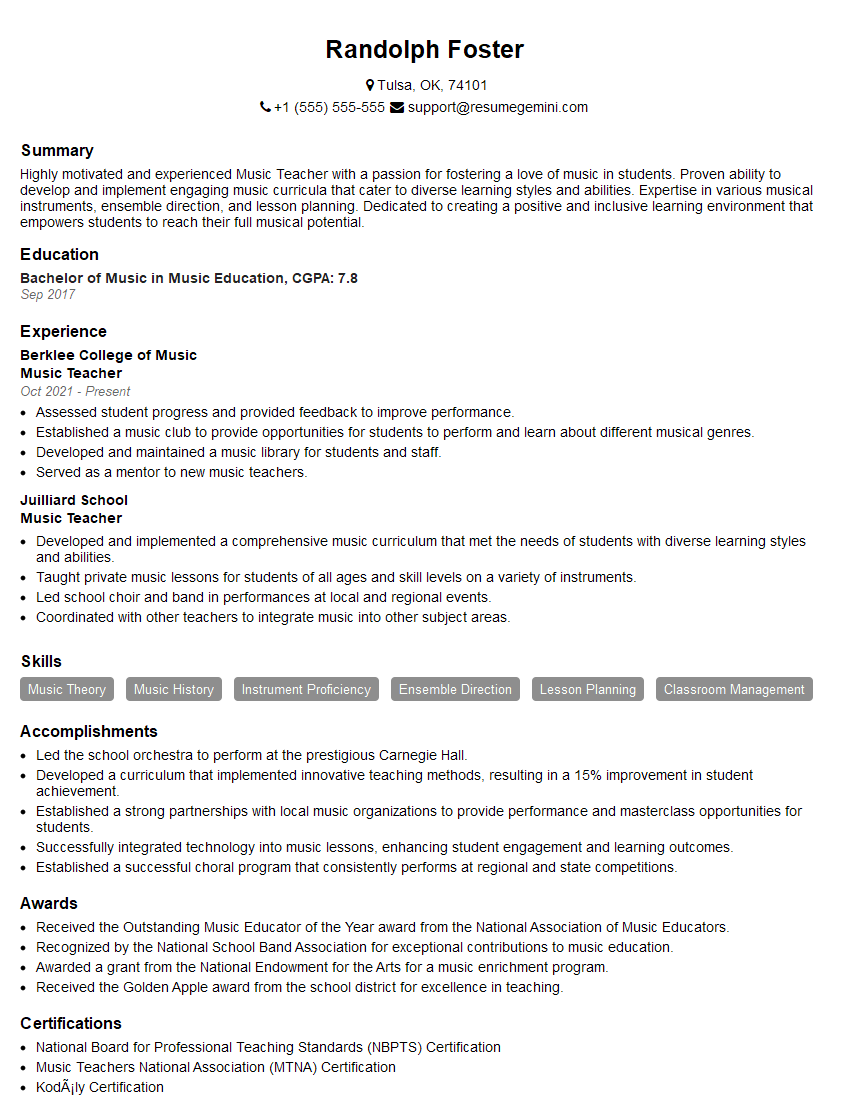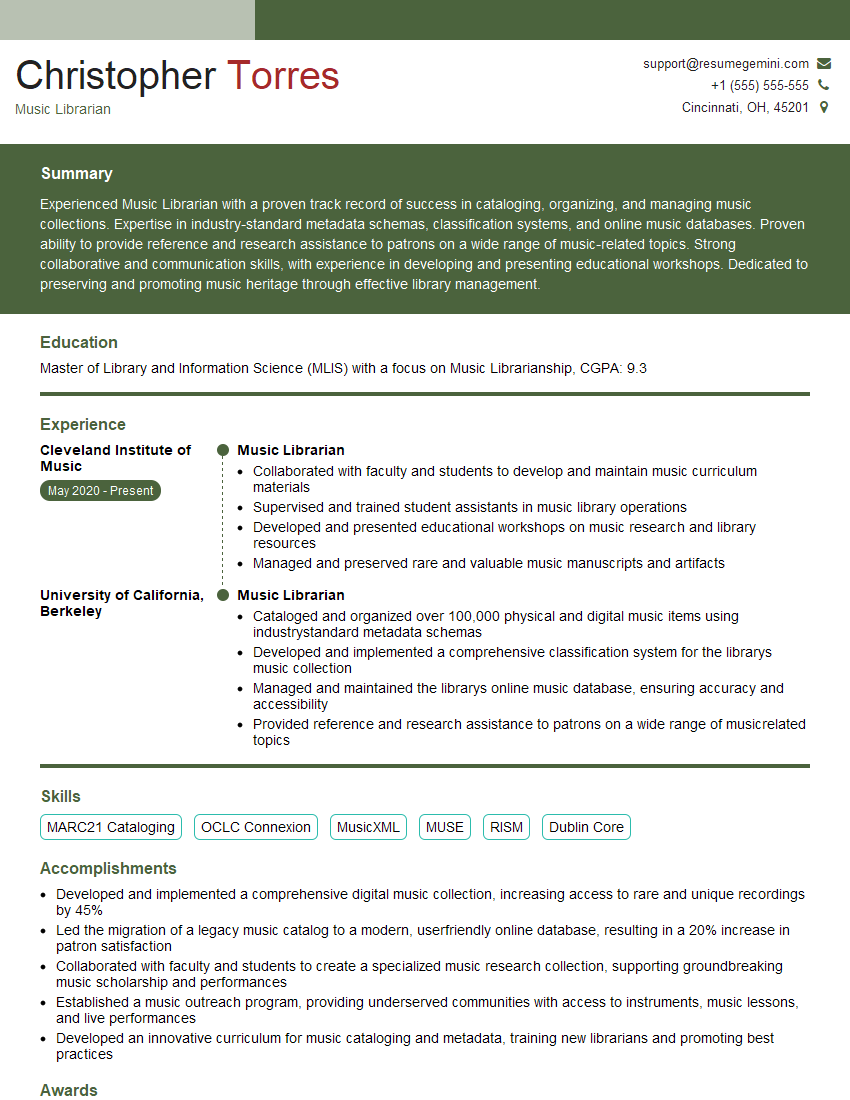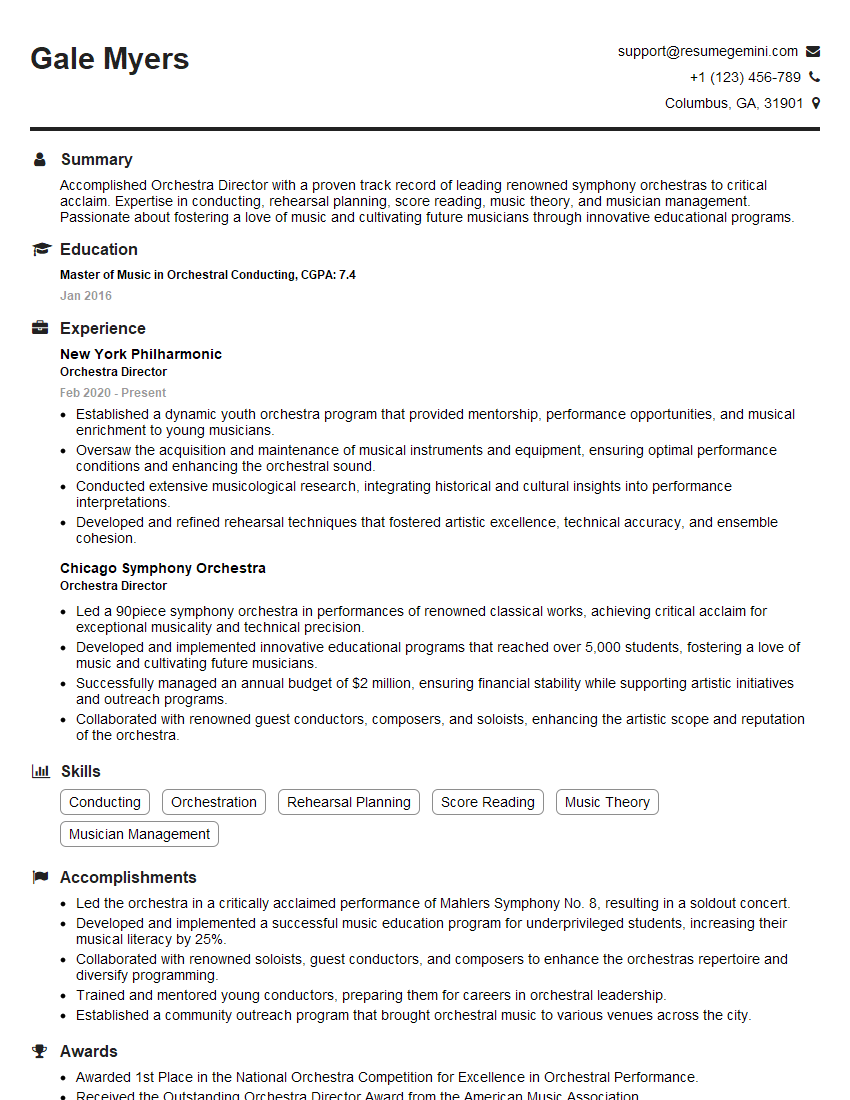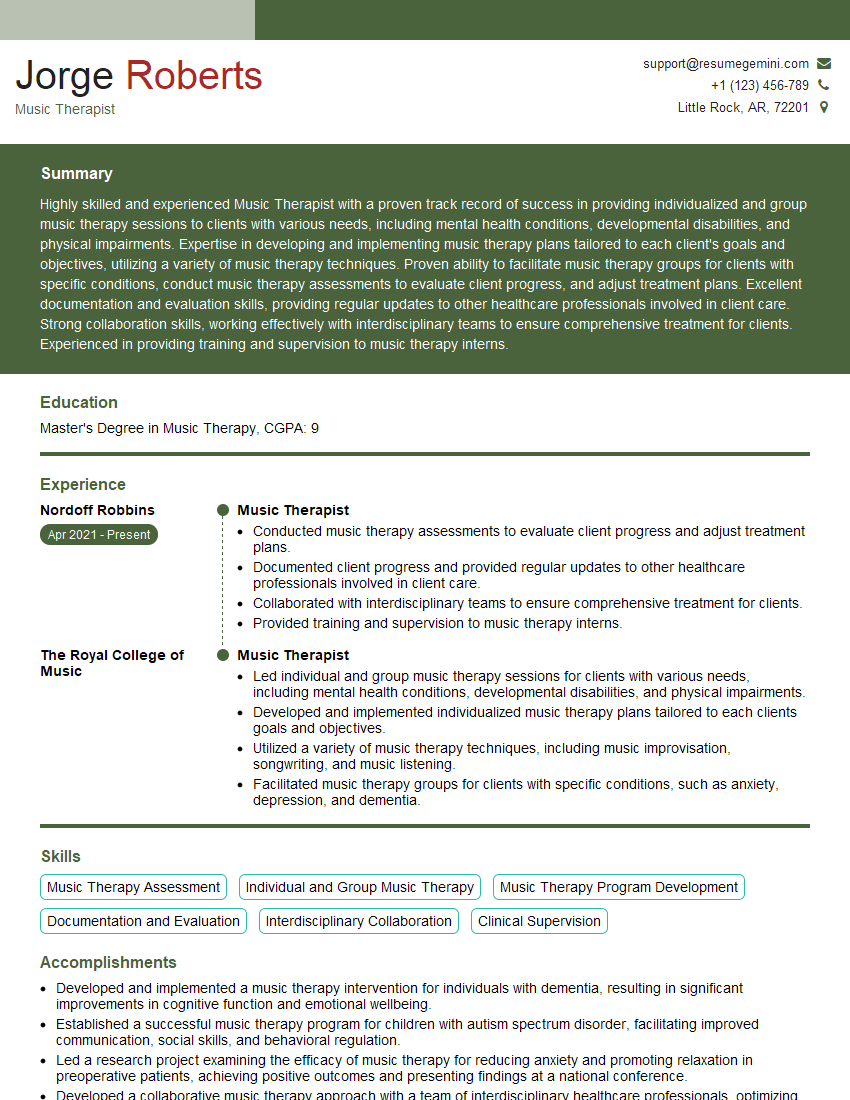Every successful interview starts with knowing what to expect. In this blog, we’ll take you through the top Experience in Music Education interview questions, breaking them down with expert tips to help you deliver impactful answers. Step into your next interview fully prepared and ready to succeed.
Questions Asked in Experience in Music Education Interview
Q 1. Describe your teaching philosophy.
My teaching philosophy centers around fostering a love for music and empowering students to become confident, creative musicians. I believe music education should be inclusive, engaging, and relevant to students’ lives. It’s not just about technical proficiency; it’s about developing critical thinking, collaboration skills, and self-expression. My approach emphasizes a balance between structured learning and student-led exploration, allowing for individual growth within a supportive community.
For example, while teaching music theory, I might start with a familiar song and dissect its structure, demonstrating concepts like melody, harmony, and rhythm in a tangible way. Then, I encourage students to compose their own simple melodies based on what they’ve learned, fostering creativity from the beginning. This method encourages active participation and connects abstract concepts to concrete experiences.
Q 2. What methods do you use to assess student progress?
Assessing student progress involves a multifaceted approach combining formative and summative assessments. Formative assessments, like regular in-class exercises, informal performances, and observation of practice habits, provide ongoing feedback and allow for adjustments to instruction. Summative assessments, such as formal performances, written tests on music theory, and projects showcasing composition or arrangement skills, offer a comprehensive overview of student achievement at key points in the course.
I also utilize rubrics for scoring performances and projects, ensuring consistent and transparent evaluation. This allows students to understand the criteria for success and track their improvement over time. Regular feedback, both verbal and written, is crucial, highlighting areas of strength and suggesting targeted areas for development.
Q 3. How do you differentiate instruction to meet diverse learning needs?
Differentiated instruction is crucial for meeting diverse learning needs. I adapt my teaching methods to cater to various learning styles and abilities. This includes providing varied learning materials, such as visual aids, auditory examples, and kinesthetic activities. For example, a student who struggles with reading music might benefit from learning through ear training and improvisation, while a visual learner might respond well to diagrams and charts illustrating musical concepts.
I also offer flexible assignments, allowing students to choose projects that align with their strengths and interests. Some students might prefer composing, while others might excel at performance or music technology. I provide scaffolding and support for struggling learners, offering individualized instruction and extra practice opportunities, while also providing extensions and challenges for advanced learners to further stimulate their abilities.
Q 4. Explain your experience with classroom management techniques.
Effective classroom management is built on establishing clear expectations and fostering a positive and respectful learning environment. From the first day, I clearly communicate classroom rules and procedures, emphasizing the importance of collaboration, respect, and responsible behavior. I believe in proactive strategies, such as engaging lesson plans and building strong relationships with students, to prevent disruptions before they occur.
When issues arise, I address them calmly and fairly, employing a range of strategies like positive reinforcement, redirection, and quiet reflection time. Consistent application of consequences for disruptive behavior ensures fairness and maintains a productive learning environment. Building a classroom culture of mutual respect and trust is paramount in creating a space where students feel safe to learn and explore their musical talents.
Q 5. How do you incorporate technology into your music instruction?
Technology plays a significant role in enriching my music instruction. Software like GarageBand and Sibelius allows students to compose, arrange, and record their music, fostering creativity and technical skills. Online platforms like YouTube and educational websites offer access to a vast library of musical resources and interactive learning tools. For instance, I use interactive music theory websites to supplement classroom lessons and provide additional practice opportunities.
Using digital audio workstations (DAWs) enables students to explore sound design and production, opening up new avenues for musical expression. Furthermore, online collaboration tools facilitate group projects, even when students are not physically together. This enhances communication and teamwork in musical projects.
Q 6. How do you foster creativity and collaboration in your music classroom?
Creativity and collaboration are central to my teaching. I create opportunities for students to express their individuality through composition, improvisation, and arranging. Group projects, such as composing a piece together or performing ensemble music, encourage collaboration and teamwork. I often facilitate jamming sessions to encourage spontaneous musical exploration and creative risk-taking.
For example, I might assign a project where students collaborate to compose a song based on a specific theme, dividing tasks based on their individual strengths. One student might focus on the melody, another on the harmony, and a third on the rhythm. This not only fosters creative problem-solving but also builds important collaborative skills, essential for success in many fields.
Q 7. What strategies do you use to engage students with different learning styles?
Catering to diverse learning styles is paramount. I incorporate a variety of teaching methods to engage students who learn through different modalities. Visual learners benefit from diagrams, charts, and videos, while auditory learners respond well to listening exercises and discussions. Kinesthetic learners thrive through movement and hands-on activities, such as playing instruments, composing through movement, and using rhythm games.
For instance, when teaching rhythm, I might use clapping patterns for kinesthetic learners, written exercises for visual learners, and rhythmic dictation for auditory learners. By offering multiple pathways to understanding musical concepts, I ensure that all students have the opportunity to grasp the material and succeed. This inclusivity creates a welcoming and effective learning environment for all.
Q 8. Describe your experience in developing and implementing music curriculum.
Developing and implementing a music curriculum requires a multifaceted approach, blending pedagogical theory with practical application. It starts with a clear understanding of learning objectives, aligned with national or state standards (if applicable), and the developmental stages of the students.
For example, in a K-5 program, I might focus on foundational music literacy – rhythm, melody, pitch, and basic music notation. This would involve creating lesson plans incorporating singing, rhythm games, and introductory instrument exploration. For a high school curriculum, the focus might shift to more advanced compositional techniques, music history analysis, and performance skills, potentially specializing in specific genres or instruments.
- Needs Assessment: I begin by assessing the students’ existing musical knowledge and skills through pre-tests, informal observations, and discussions.
- Curriculum Mapping: I then map out the curriculum, sequencing learning objectives logically and progressively throughout the year or semester. This often involves choosing suitable textbooks, supplementary materials, and digital resources.
- Lesson Planning: Detailed lesson plans are crucial. Each plan includes clear learning objectives, activities, assessment strategies, and differentiation strategies to cater to diverse learning styles and needs.
- Assessment and Evaluation: The curriculum includes regular formative and summative assessments to track student progress. This might include written tests, practical performance assessments, and projects.
Throughout the process, ongoing reflection and adjustments are vital. I regularly review student data, seek feedback from students and colleagues, and adapt the curriculum to meet the evolving needs of the learners.
Q 9. How do you assess students’ musical performance skills?
Assessing musical performance requires a holistic approach, considering technical skill, musicality, and expressiveness. I avoid focusing solely on technical accuracy; instead, I emphasize the student’s ability to communicate musical ideas effectively.
- Rubrics: I use clearly defined rubrics that outline the criteria for evaluation. These rubrics are usually shared with students beforehand so they understand expectations.
- Observation: I carefully observe students during rehearsals and performances, noting their posture, intonation, rhythm, dynamics, and overall musicality.
- Recorded Performances: Recording performances allows for detailed analysis and feedback. Students can self-assess by reviewing their recordings.
- Peer Assessment: Engaging students in peer assessment develops their critical listening skills and encourages constructive feedback within the class.
- Self-Assessment: Encouraging students to reflect on their own performances allows them to take ownership of their learning and identify areas for improvement.
Feedback is always constructive and focused on both strengths and areas for growth. I provide specific examples, not just general comments. For example, instead of saying “your intonation was off,” I might say, “Your intonation was slightly sharp on the high notes of the melody. Let’s try focusing on breath control and vocal placement to improve this.”
Q 10. How do you handle student discipline issues in a music setting?
Discipline in a music setting requires a proactive and positive approach. Punitive measures are rarely effective and can damage the learning environment. Instead, I focus on building a respectful and supportive classroom community.
- Establishing Clear Expectations: From the beginning, I establish clear expectations regarding behavior and participation. This includes rules for instrument handling, respectful communication, and active listening.
- Positive Reinforcement: I emphasize positive reinforcement, celebrating successes and accomplishments. This creates a positive learning environment.
- Restorative Practices: For minor infractions, I use restorative practices such as conversations to understand the root cause of the behavior and work collaboratively to find solutions.
- Collaboration with Parents/Guardians: For more serious issues, I communicate openly with parents or guardians, seeking their support and guidance.
- Consequences: While I avoid punishment, consequences for consistent disruptive behavior may include loss of privileges (such as solo performance opportunities) or a meeting with administration.
My goal is to help students understand the impact of their behavior on themselves and others and to develop self-regulation skills. I believe that a positive and supportive classroom climate is essential for fostering musical learning and growth.
Q 11. What experience do you have with instrumental or vocal instruction?
I have extensive experience in both instrumental and vocal instruction. My instrumental experience includes teaching woodwinds (flute, clarinet, saxophone) and brass (trumpet, trombone). In vocal instruction, I’ve worked with students of all ages and skill levels, from beginners to advanced singers. I’ve also conducted choirs and ensembles.
My teaching approach adapts to the instrument or voice type. For example, with woodwinds, I emphasize proper embouchure and breathing techniques. With brass instruments, I focus on breath support and articulation. For vocal students, I work on breath control, posture, and vocal technique, always emphasizing healthy vocal habits to avoid injury.
I incorporate a variety of teaching methodologies, including individual instruction, group classes, and ensemble rehearsals. I regularly assess student progress and provide tailored feedback to address individual needs and challenges.
Q 12. How do you build positive relationships with parents and guardians?
Building strong parent-guardian relationships is crucial for student success. Open communication is key. I ensure parents are informed about their child’s progress, challenges, and upcoming performances or events.
- Regular Communication: I utilize various methods like newsletters, email updates, parent-teacher conferences, and informal check-ins to keep parents informed.
- Positive Feedback: I focus on sharing both successes and areas for growth in a positive and encouraging way.
- Accessibility: I make myself readily available to answer parent questions and concerns, whether via phone, email, or scheduled meetings.
- Collaboration: I view parents as partners in their child’s musical education. I seek their input and collaborate with them to support the student’s learning journey.
- Showcasing Student Work: Regular performances and showcases provide opportunities to celebrate student achievement with parents.
By creating a welcoming and inclusive environment where parents feel valued and respected, I build trust and foster a strong home-school connection that benefits the student.
Q 13. Describe a time you had to adapt your lesson plans due to unforeseen circumstances.
One memorable instance involved a planned recorder concert where a significant number of students were absent due to a sudden flu outbreak. My initial lesson plan, which heavily relied on ensemble rehearsal, became impossible to implement.
I quickly adapted by focusing on individual skills. Instead of a full ensemble performance, I developed alternative activities, including:
- Individual recorder technique exercises: Students worked on specific technical challenges at their own pace.
- Music theory reinforcement: We reviewed key concepts related to the concert pieces.
- Improvisation activities: Students explored musical creativity through improvisational exercises using their recorders.
- Listening activities: We analyzed recordings of professional recorder performances, focusing on phrasing and expression.
While the planned concert was postponed, students still received valuable musical instruction. This experience reinforced the importance of flexibility and adaptability in lesson planning.
Q 14. How do you promote inclusivity and equity in your music classroom?
Promoting inclusivity and equity in my music classroom is paramount. I strive to create a space where all students feel welcome, valued, and respected regardless of their background, abilities, or experiences.
- Diverse repertoire: I choose musical repertoire that reflects the diversity of cultures and musical styles, exposing students to a wide range of musical traditions.
- Adaptive instruction: I adapt my teaching methods and materials to meet the individual needs of all students, including those with disabilities or learning differences.
- Culturally responsive teaching: I incorporate culturally relevant musical examples and activities into my lessons, celebrating the unique contributions of different cultures to music.
- Inclusive assessment: I use a variety of assessment methods that cater to different learning styles and abilities. This may include written assessments, oral presentations, and practical performance assessments.
- Safe and supportive environment: I foster a safe and supportive classroom environment where students feel comfortable expressing themselves and sharing their ideas.
Creating an equitable environment where all students have equal opportunities to succeed requires ongoing reflection and continuous improvement. I am always seeking ways to enhance my practice and create a truly inclusive and equitable music classroom.
Q 15. What is your experience with music theory instruction?
My experience with music theory instruction spans over 15 years, encompassing both individual and group settings. I’ve taught students ranging from elementary school beginners to advanced high school students preparing for college auditions. My approach emphasizes a balanced understanding of both the theoretical concepts and their practical applications. I start with the fundamentals, like intervals, scales, and chords, gradually building toward more complex topics like counterpoint, harmony, and analysis. I use a variety of teaching methods, including lectures, interactive exercises, ear training, and practical composition assignments. For example, when teaching harmony, I’ll often have students analyze existing pieces before composing their own short melodies with specific harmonic progressions. I also utilize technology, incorporating music notation software like Finale or Sibelius to create interactive lessons and assignments.
Career Expert Tips:
- Ace those interviews! Prepare effectively by reviewing the Top 50 Most Common Interview Questions on ResumeGemini.
- Navigate your job search with confidence! Explore a wide range of Career Tips on ResumeGemini. Learn about common challenges and recommendations to overcome them.
- Craft the perfect resume! Master the Art of Resume Writing with ResumeGemini’s guide. Showcase your unique qualifications and achievements effectively.
- Don’t miss out on holiday savings! Build your dream resume with ResumeGemini’s ATS optimized templates.
Q 16. What experience do you have with music history instruction?
My music history instruction focuses on engaging students with the historical context of music, rather than simply memorizing dates and names. I weave storytelling into my lessons, connecting composers’ lives and the socio-political climate of their time to the music they created. For instance, when teaching about the Baroque period, I might explore the rise of opera and its connection to the courtly culture of the time, using audio and visual materials to bring the era to life. I believe understanding the cultural forces that shaped music enhances appreciation and interpretation. My approach uses a combination of lectures, discussions, listening assignments, and research projects. Students often present their research findings to the class, fostering critical thinking and collaborative learning. For example, students have researched and presented on specific composers or musical movements, culminating in presentations utilizing multimedia resources.
Q 17. How do you create a positive and supportive learning environment?
Creating a positive and supportive learning environment is crucial for fostering musical growth. I achieve this through several key strategies. First, I establish a classroom culture of respect and inclusivity, where every student feels safe to take risks and express themselves musically. Second, I prioritize individualized instruction, tailoring my teaching to each student’s unique learning style and needs. This often involves providing differentiated instruction and flexible pacing. For example, some students benefit from visual aids, while others learn best through kinesthetic activities. Third, I encourage collaboration through group work, ensemble playing, and peer feedback, fostering a sense of community among students. Finally, I celebrate successes—both big and small—and provide constructive feedback to support continued improvement. A relaxed atmosphere where mistakes are seen as learning opportunities is essential.
Q 18. Describe your experience working with students with special needs.
I have extensive experience working with students with diverse learning needs, including students with autism, ADHD, and learning disabilities. My approach involves adapting my teaching methods to meet their individual requirements. This might involve breaking down tasks into smaller, more manageable steps, providing visual cues and supports, using assistive technologies, or modifying assessment methods. I collaborate closely with special education teachers and therapists to develop individualized education programs (IEPs) that cater to each student’s unique strengths and challenges. For example, a student with autism might benefit from a structured learning environment with clear expectations and predictable routines, while a student with ADHD might benefit from frequent breaks and opportunities for movement. Understanding and adapting to each student’s learning style is paramount.
Q 19. How do you stay current with best practices in music education?
Staying current with best practices in music education is an ongoing process. I actively participate in professional development opportunities, including conferences, workshops, and online courses. I regularly read educational journals and research articles, and I actively engage in online communities of music educators, sharing ideas and best practices. I also attend concerts and performances, keeping abreast of new trends and developments in the field. Furthermore, I seek feedback from my students and colleagues, constantly evaluating my teaching methods and seeking ways to enhance student learning. This dynamic process allows me to integrate new ideas and technologies into my curriculum, ultimately benefiting my students.
Q 20. What is your experience with conducting ensembles?
I have extensive experience conducting various ensembles, including choirs, bands, and orchestras, at different levels of proficiency. My conducting style focuses on clear communication and fostering musical expression. I strive to create a collaborative environment where musicians feel empowered and inspired. My approach includes detailed rehearsal planning, focusing on sectional work and individual coaching to develop musicianship. I also emphasize musical interpretation, encouraging students to understand the composer’s intent and to convey emotion through their performance. I utilize a variety of conducting techniques to support clear communication, adjusting my style according to the needs of the ensemble and the repertoire. This collaborative approach enhances ensemble cohesion and fosters a love for musical performance.
Q 21. Describe your experience with music performance assessment.
My experience with music performance assessment emphasizes a holistic approach, evaluating not only technical proficiency but also musicality, expression, and artistry. I employ a variety of assessment methods, including formal performances, informal assessments during rehearsals, and written evaluations. I provide constructive feedback, focusing on both strengths and areas for improvement, helping students set goals for future development. My assessments incorporate rubrics and checklists to ensure fairness and consistency. I also provide opportunities for students to self-assess their performance and reflect on their progress. The goal is not just to judge performance but to foster growth and a deeper understanding of musical expression and artistic communication.
Q 22. How do you select appropriate repertoire for your students?
Selecting appropriate repertoire is crucial for student success and engagement. It’s not just about picking pretty songs; it’s about finding pieces that align with students’ skill levels, interests, and learning goals. I use a multi-faceted approach.
- Skill Level Assessment: I begin by carefully assessing each student’s current abilities. This includes evaluating their technical proficiency (e.g., rhythmic accuracy, note reading, finger dexterity), musical understanding (e.g., phrasing, dynamics, articulation), and musicality (e.g., expression, interpretation).
- Student Interest: I incorporate student preferences whenever possible. I might ask them about their favorite genres, composers, or songs, then search for suitable arrangements or pieces within those styles. This fosters a sense of ownership and enthusiasm.
- Educational Objectives: The repertoire should also support specific learning objectives for the course or unit. For example, if I’m focusing on developing sight-reading skills, I’ll select pieces with progressively challenging rhythmic and melodic patterns. If we’re working on dynamics, I will choose pieces with a wide range of dynamic markings.
- Variety and Balance: A balanced repertoire is essential. It should expose students to diverse styles, periods, and composers, encouraging exploration and broadening their musical horizons. I avoid overwhelming them with overly challenging pieces but challenge them incrementally.
- Accessibility: Finally, I consider the availability of resources. This includes the cost of sheet music, the availability of accompaniment tracks, and the suitability of the arrangement for the available instruments or voices.
For example, with beginner piano students, I might start with simple, well-known children’s songs adapted for piano, gradually introducing more complex pieces as their skills improve. With a more advanced choir, I’d select pieces with challenging harmonies and vocal ranges, ensuring the pieces are appropriate for their vocal capabilities while still pushing their boundaries.
Q 23. What experience do you have with music technology software and hardware?
I’m proficient in using various music technology software and hardware to enhance my teaching and students’ learning experiences. My experience encompasses:
- Digital Audio Workstations (DAWs): I’m familiar with GarageBand, Logic Pro X, and Ableton Live. I use these for creating backing tracks, composing original music with students, and recording student performances for self-assessment and feedback.
- Notation Software: I use Sibelius and Finale for creating and editing scores, generating customized exercises, and providing students with high-quality printed music.
- Music Production Hardware: My experience with MIDI keyboards, audio interfaces, and microphones allows me to create a more immersive and engaging learning environment. This is particularly useful for composing and recording projects.
- Interactive Whiteboards and Projectors: I effectively integrate these technologies to present musical concepts visually, display scores, and facilitate collaborative activities.
- Online Learning Platforms: I utilize platforms such as Google Classroom and Moodle to share resources, provide assignments, and communicate with students effectively.
For instance, I’ve used GarageBand to create custom backing tracks for student performances, allowing them to focus on their individual parts while still enjoying the experience of performing with accompaniment. I also use notation software to generate customized exercises for students working on specific technical skills, such as scales and arpeggios.
Q 24. How do you address the challenges of teaching music in a resource-constrained environment?
Teaching music in a resource-constrained environment requires creativity and adaptability. My strategies include:
- Creative Resourcefulness: I leverage free or low-cost resources like online sheet music libraries, YouTube tutorials, and open-source software. I often adapt existing materials to fit my students’ needs and the available resources.
- Community Engagement: I actively seek partnerships with local businesses, community organizations, and other schools to secure funding, instruments, or other essential resources.
- Student-Centered Learning: I prioritize activities that require minimal materials. This might include call-and-response exercises, body percussion, improvisation, and creating music using found sounds.
- Collaborative Learning: Students can learn from each other. Peer teaching and group projects can be effective tools in resource-limited environments.
- Focus on Fundamentals: I concentrate on foundational musical skills that don’t require expensive equipment or resources. For example, I focus on developing aural skills, rhythmic understanding, and basic music theory concepts.
For example, in a school lacking adequate instruments, I’ve successfully implemented body percussion units, utilizing students’ bodies as instruments to create rhythmic patterns and explore musical textures. We’ve also created music using everyday objects as percussion instruments (like pots, pans, and wooden spoons).
Q 25. What are your goals for student achievement in your music classroom?
My primary goals for student achievement encompass several key areas:
- Technical Proficiency: Students will demonstrate mastery of fundamental musical skills appropriate to their instrument or vocal part, such as accurate note reading, rhythmic precision, and proper technique.
- Musical Understanding: Students will develop a deeper understanding of musical concepts such as melody, harmony, rhythm, form, and dynamics, demonstrating their knowledge through analysis, performance, and composition.
- Creative Expression: Students will develop their creativity and self-expression through improvisation, composition, and performance, demonstrating originality and artistic voice.
- Appreciation of Music: Students will broaden their appreciation of diverse musical styles, cultures, and historical periods, demonstrating informed listening skills and critical thinking about music.
- Collaboration and Teamwork: Students will learn to collaborate effectively with peers, demonstrating teamwork, communication, and respect in ensemble settings.
These goals are not mutually exclusive; rather, they are interconnected and build upon each other. Success in one area often supports success in others. For instance, a student who develops strong technical skills is better equipped to express themselves creatively and appreciate the nuances of musical performance.
Q 26. How do you use formative and summative assessment to inform your teaching?
Formative and summative assessments are crucial for guiding my teaching and monitoring student progress. Formative assessment is ongoing, providing feedback throughout the learning process, while summative assessment provides a final evaluation of learning outcomes.
- Formative Assessment: I use various techniques, including informal observation during class, brief quizzes, individual or group performance checks, and peer assessment. This allows for immediate feedback and adjustments to my teaching approach. I might, for example, observe students struggling with a particular rhythmic pattern during rehearsal, then adjust my teaching to focus on that specific skill before moving on.
- Summative Assessment: This includes formal tests, unit exams, major performances (concerts, recitals), and portfolios showcasing student work. These assessments provide a comprehensive overview of student achievement at the end of a unit or course. A student’s final grade, for instance, might reflect their performance in a concert, a written theory test, and a portfolio of compositions.
I use the data from both formative and summative assessments to inform my instructional decisions, refining my teaching methods and adjusting my curriculum to better meet students’ needs. For example, if formative assessments reveal that a large number of students are struggling with a particular concept, I’ll adjust my lesson plans to provide more targeted instruction and practice opportunities.
Q 27. Describe your experience in collaborating with other teachers or departments.
Collaboration is vital in music education. I’ve had positive experiences collaborating with various teachers and departments:
- Cross-Curricular Projects: I’ve collaborated with English and history teachers to create interdisciplinary projects that integrate music with other subjects. This has enhanced students’ understanding of historical contexts and fostered creative writing skills through songwriting and musical composition inspired by historical events or literature.
- Shared Resources and Facilities: I’ve worked with other arts teachers to share resources such as instruments, equipment, and performance spaces, maximizing the use of available resources and creating a more collaborative school environment.
- Combined Performances: I’ve coordinated joint performances with other music ensembles (bands, orchestras, choirs) and drama departments, resulting in richer and more engaging performances for both students and audiences.
- Student Support Collaboration: I work closely with counselors and special education teachers to ensure that all students have the support they need to succeed in music class, addressing individual learning needs and challenges.
One example involved a collaboration with the drama department where music students composed original music for a school play, providing a hands-on experience in composition and collaboration and enriching the play itself. This kind of collaboration extends students’ learning beyond the boundaries of a single subject.
Q 28. What is your approach to professional development in music education?
Professional development is ongoing and essential for staying current in the field of music education. My approach is multifaceted:
- Workshops and Conferences: I actively participate in professional development workshops and conferences focused on innovative teaching strategies, new technologies, and current research in music education. This allows me to learn from other educators and stay updated on best practices.
- Mentorship and Collaboration: I seek out opportunities for mentoring and collaboration with experienced music educators, sharing ideas and learning from their expertise. Peer learning and feedback are invaluable.
- Self-Directed Learning: I engage in self-directed learning through reading professional journals, attending webinars, and exploring online resources. This allows me to continuously expand my knowledge and skills independently.
- Reflection and Assessment: I regularly reflect on my teaching practices and seek feedback from students, colleagues, and administrators. This reflective practice allows me to identify areas for improvement and refine my teaching approaches.
Recently, I attended a workshop on incorporating technology into music education, which provided me with new strategies for using digital tools to enhance my teaching. Continuous professional development ensures I can provide the most effective and engaging learning experiences for my students.
Key Topics to Learn for Your Music Education Interview
- Curriculum Development & Implementation: Understanding different pedagogical approaches, adapting curriculum to diverse learners, and assessing student progress effectively.
- Classroom Management & Engagement: Strategies for creating a positive and productive learning environment, managing student behavior, and fostering a love of music.
- Instrumental/Vocal Instruction Techniques: Demonstrating expertise in your specific instrument(s) or vocal training, including effective teaching methodologies and addressing common student challenges.
- Assessment & Evaluation: Developing and implementing fair and reliable assessment methods, providing constructive feedback, and using assessment data to inform instruction.
- Technology Integration in Music Education: Utilizing technology effectively to enhance learning, such as music software, digital audio workstations (DAWs), and online resources.
- Collaboration & Communication: Working effectively with colleagues, parents, and administrators; clearly communicating your teaching philosophy and goals.
- Music Theory & History: Demonstrating a strong understanding of fundamental music theory concepts and the historical context of music, enabling you to effectively teach these subjects.
- Differentiated Instruction: Adapting teaching methods to meet the diverse learning needs of all students, including students with disabilities or gifted learners.
- Professional Development & Growth: Showcasing your commitment to continuous learning and professional development within the music education field.
Next Steps
Mastering the key aspects of music education is crucial for career advancement, opening doors to rewarding opportunities and leadership roles within schools and musical organizations. A well-crafted resume is your first impression – make it count! Creating an ATS-friendly resume significantly improves your chances of getting your application noticed. To help you build a compelling and effective resume, leverage the power of ResumeGemini. ResumeGemini provides a user-friendly platform and offers examples of resumes tailored to Music Education experience, ensuring your qualifications shine.
Explore more articles
Users Rating of Our Blogs
Share Your Experience
We value your feedback! Please rate our content and share your thoughts (optional).
What Readers Say About Our Blog
Hello,
We found issues with your domain’s email setup that may be sending your messages to spam or blocking them completely. InboxShield Mini shows you how to fix it in minutes — no tech skills required.
Scan your domain now for details: https://inboxshield-mini.com/
— Adam @ InboxShield Mini
Reply STOP to unsubscribe
Hi, are you owner of interviewgemini.com? What if I told you I could help you find extra time in your schedule, reconnect with leads you didn’t even realize you missed, and bring in more “I want to work with you” conversations, without increasing your ad spend or hiring a full-time employee?
All with a flexible, budget-friendly service that could easily pay for itself. Sounds good?
Would it be nice to jump on a quick 10-minute call so I can show you exactly how we make this work?
Best,
Hapei
Marketing Director
Hey, I know you’re the owner of interviewgemini.com. I’ll be quick.
Fundraising for your business is tough and time-consuming. We make it easier by guaranteeing two private investor meetings each month, for six months. No demos, no pitch events – just direct introductions to active investors matched to your startup.
If youR17;re raising, this could help you build real momentum. Want me to send more info?
Hi, I represent an SEO company that specialises in getting you AI citations and higher rankings on Google. I’d like to offer you a 100% free SEO audit for your website. Would you be interested?
Hi, I represent an SEO company that specialises in getting you AI citations and higher rankings on Google. I’d like to offer you a 100% free SEO audit for your website. Would you be interested?
good
